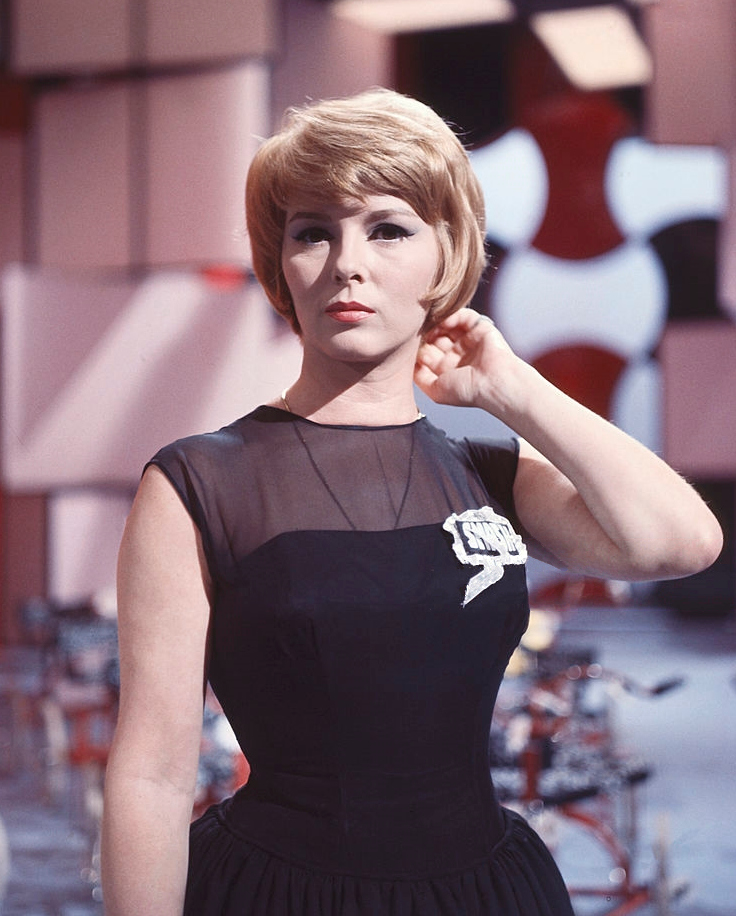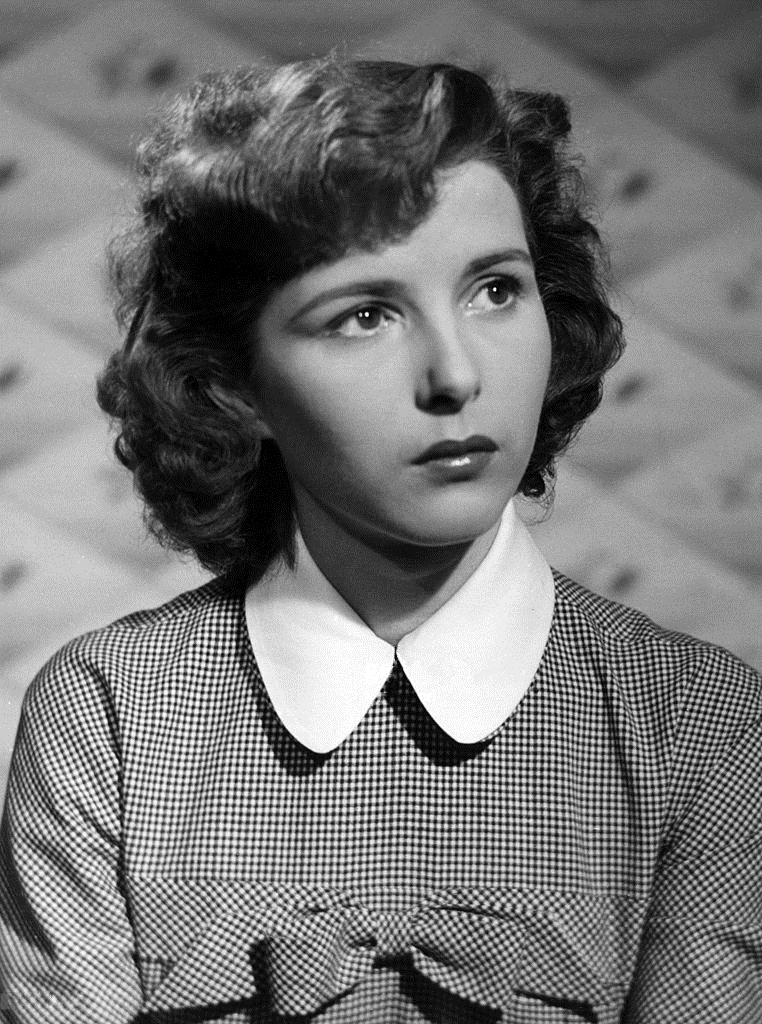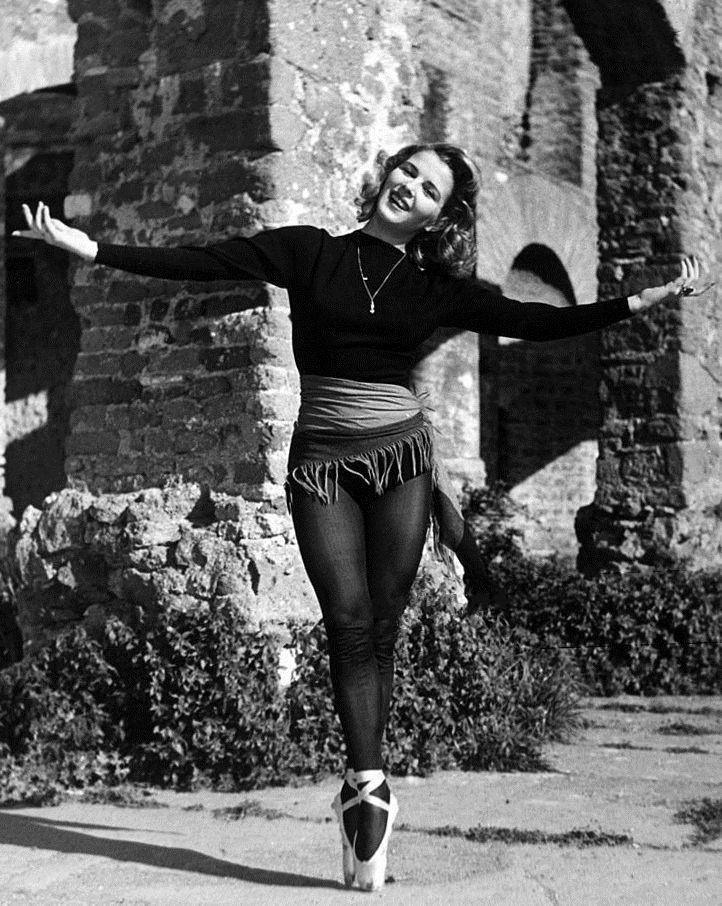1. Early Life and Background
Delia Scala's early life was marked by her birth in a small Italian town and her subsequent move to Milan, where she began her rigorous artistic training.
1.1. Birth and Childhood
Delia Scala was born as Odette Bedogni on 25 September 1929, in Bracciano, Lazio, Italy. When she was a young girl, her family relocated to Milan, a major cultural and artistic center in Italy.
1.2. Education
In Milan, Scala embarked on an extensive ballet education at the prestigious "La Scala" Ballet School. She dedicated seven years to her ballet training, a period that laid a strong foundation for her versatile performing career across various artistic disciplines.
2. Career
Delia Scala's professional journey was multifaceted, encompassing a successful career in ballet, a prolific period in film, a groundbreaking role in musical theatre, and a significant presence in early Italian television and radio.
2.1. Ballet Career
Scala began her artistic career as a professional ballerina. She performed in numerous ballets until the outbreak of World War II. Following the war, she transitioned from classical ballet to other performing arts, adopting the stage name Delia Scala.
2.2. Film Career
After her ballet career, Delia Scala became a prominent figure in Italian cinema, appearing in a wide range of motion pictures. Her filmography includes notable works such as Difficult Years (Anni difficili, 1948), Side Street Story (Napoli milionaria, 1950), Rome 11:00 (Roma ore 11, 1952), Touchez pas au grisbi (1954), and Gentlemen Are Born (Signori si nasce, 1960). Her final film role was in Le olimpiadi dei mariti in 1960.
| Year | Title | Role(s) | Notes |
|---|---|---|---|
| 1943 | Principessina | Classmate | Cameo appearance |
| 1947 | Difficult Years | Elena | |
| 1948 | L'eroe della strada | Giulietta Marchi | |
| 1949 | Ti ritroverò | Maria Riva | |
| 1950 | How I Discovered America | Lisa | |
| Side Street Story | Maria Rosaria | ||
| A Dog's Life | Vera | ||
| The Cliff of Sin | Anna | ||
| 1951 | Beauties on Bicycles | Delia | |
| Song of Spring | Rosetta | ||
| Cameriera bella presenza offresi... | Wife | Cameo appearance | |
| Auguri e figli maschi! | Silvana Sostacchini | ||
| The Steamship Owner | Herself | Although playing herself, she was the lead actress | |
| Messalina | Cinzia | ||
| Appointment for Murder | Silvia Pietrangeli | ||
| 1952 | I'm the Hero | Silvia | |
| Rome 11:00 | Angelina | ||
| The Dream of Zorro | Estrella | ||
| Giovinezza | Tamara | ||
| Ragazze da marito | Gabriella | ||
| The Flame | Teresa Derrieux | ||
| 1953 | Matrimonial Agency | Mitzi | |
| Gioventù alla sbarra | Franca | ||
| Viva il cinema! | Palmina | ||
| Cavalcade of Song | Titina | Segment: "Io cerco la Titina" | |
| 1954 | Public Opinion | Lauretta | |
| Di qua, di là del Piave | Angiolina | Segment: "Angiolina, bella Angiolina" | |
| Gran varietà | The Dancer | Segment: "Il fine dicitore" | |
| Cañas y barro | Marieta | ||
| Before the Deluge | Josette | ||
| Touchez pas au grisbi | Hughette | ||
| My Seven Little Sins | Luisella | ||
| 1955 | Magic Village | Agatina | |
| 1956 | Goubbiah, mon amour | Trinida | |
| 1960 | Terror in Oklahoma | Betsabea | |
| Gentlemen Are Born | Patrizia | ||
| I Teddyboys della canzone | Delia Amato | ||
| Madri pericolose | Maura Ornano | ||
| Le olimpiadi dei mariti | Delia | Final film role |
2.3. Stage and Commedia Musicale
In 1954, Delia Scala made her theatre debut with Giove in doppiopetto (Double-breasted Jupiter). This show is widely regarded as the first commedia musicale, an Italian musical genre innovated by playwrights Pietro Garinei and Sandro Giovannini, with musical collaboration from Gorni Kramer. This marked a pivotal moment in her career and in Italian entertainment history.
Scala went on to star in several other major stage productions, often collaborating with renowned actors and directors. These include Buonanotte Bettina (Goodnight Bettina, 1956) alongside Walter Chiari, L'adorabile Giulio (The Adorable Giulio, 1957) with Carlo Dapporto, Un trapezio per Lisistrata (A Trapeze for Lisistrata, 1958) featuring Nino Manfredi and Paolo Panelli, the Delia Scala Show (1960), Rinaldo in campo (Rinaldo into the Field, 1961) with Domenico Modugno, My Fair Lady (1964) opposite Gianrico Tedeschi and Mario Carotenuto, and Il giorno della tartaruga (The Day of the Turtle, 1965) with Renato Rascel.
| Year | Show | Role(s) | Notes |
|---|---|---|---|
| 1937 | La Boutique fantasque | Dancer | Teatro alla Scala, April 1937 |
| The Sleeping Beauty | Dancer | Teatro alla Scala, October 1937 | |
| 1940 | Zazà | Dufresne's daughter | Teatro alla Scala, April 1940 |
| 1954 | Giove in doppiopetto | Lia | Teatro Lirico, September 1954 |
| 1956 | Buonanotte Bettina | Bettina | Teatro Alfieri, November-December 1956 |
| 1957 | The Tempest | Ariel | Palazzo Giusti, July 1957 |
| L'adorabile Giulio | Penny | Teatro Sistina, November 1957 | |
| 1958 | Un trapezio per Lisistrata | Lisistrata | Teatro Sistina, October 1958 |
| 1961 | Delia Scala Show | Herself | Teatro Biondo, March 1961 |
| Rinaldo in campo | Angelica | Teatro Alfieri, September 1961 | |
| 1963 | My Fair Lady | Eliza Doolittle | Teatro Nuovo, November 1963 |
| 1964 | Il giorno della tartaruga | Maria / Maria's mother / Federica | Teatro Sistina, October 1964 |
2.4. Television Career
Delia Scala also made significant contributions to Italian television. In 1956, she appeared in the TV show Lui e Lei (Him and Her) with Nino Taranto. From 1959 to 1960, she co-hosted the highly popular variety and musical show Canzonissima alongside Nino Manfredi and Paolo Panelli.
After a period of retirement from live performances, Scala returned to television. From 1980 to 1983, she conceived and hosted Una rosa per la Vita (A Rose for Life), a show dedicated to raising funds for cancer prevention and research, held at the Bussoladomani arena in Lido di Camaiore, with Raimondo Vianello and Sandra Mondaini. In 1982, she returned to RAI television with the fiction series Casa Cecilia (Cecilia's Home), where she played the lead role for three seasons until 1987. Her final television role was as Delia, the mother, in the sitcom Io e la mamma (Mum and I), which aired on Canale 5 between 1996 and 1998.

| Year | Title | Role(s) | Notes |
|---|---|---|---|
| 1956 | Lui e lei | Herself / co-host | Talk show |
| 1959-1960 | Canzonissima | Herself / Host | Variety/musical show (season 2) |
| 1961 | La padrona di Raggio di Luna | Marta Gray | Television movie |
| 1968 | Delia Scala Story | Herself / Host | Variety show |
| 1970 | Signore e signora | Herself / Host | Variety show |
| 1972 | Colazione allo studio sette | Herself / Host | Variety show |
| 1975 | Tanto piacere | Herself / Guest | Talk show |
| 1978-1979 | Che combinazione | Herself / Host | Variety show (season 1) |
| 1982-1987 | Casa Cecilia | Cecilia | Lead role |
| 1987 | Telegatto 1987 | Herself / Host | Annual ceremony |
| 1997-1998 | Io e la mamma | Delia, the mother | Co-lead role (final television role) |
2.5. Radio Career
Delia Scala also participated in radio productions. In 1972, she was involved in the radio podcast The Mistress of the Inn, where she played the role of Mirandolina.
| Year | Title | Role(s) | Notes |
|---|---|---|---|
| 1972 | The Mistress of the Inn | Mirandolina | Radio podcast |
2.6. Retirement and Comeback
After twelve consecutive years of performances across Italy and Europe, Delia Scala began to experience fatigue. In 1965, at the peak of her success and having received offers from Broadway, she made the sudden decision to withdraw from live performances. In 1966, she married and temporarily retired to focus on her family life.
Her retirement was not permanent. In 1968, Scala made a comeback with Delia Scala Story, a show specifically written for her by Garinei and Giovannini. This was followed in 1970 by the highly successful Signore e signora (Mr. and Madame) with Lando Buzzanca. After another nine-year break, she starred in the show Che combinazione (What a Coincidence) alongside Don Lurio.
3. Personal Life
Despite her immense professional success and popularity, Delia Scala's personal life was marked by a series of misfortunes and tragedies.
3.1. Relationships and Marriages
In 1946, at the age of 17, Delia Scala married a Greek military officer who had come to Italy to join the partisan forces fighting against the Nazi-fascists. However, their marriage was short-lived, and they separated two years later. The marriage was eventually voided in 1956.
During the mid-1950s, Scala was engaged to Formula One race car driver Eugenio Castellotti. Their relationship ended tragically in 1957 when Castellotti died after his Ferrari crashed while attempting a speed record at the Modena race track.
In 1967, she married Piero Giannotti. This marriage lasted until 1982 when Giannotti died of a heart attack while cycling along the beach in Viareggio. Scala married for a third time in 1985 to industrialist Arturo Fremura. This marriage also ended with the death of her husband in 2001, who succumbed to liver cancer.
3.2. Health
In 1974, Delia Scala was diagnosed with breast cancer. She underwent a radical mastectomy and appeared to make a full recovery from the illness. However, in 2002, she was struck by the same illness again.
4. Death
Delia Scala died on 15 January 2004, at the age of 74, in Livorno, Tuscany, Italy. Her resting place is in the Cimitero della Misericordia in Livorno.
5. Legacy and Recognition
Delia Scala left an indelible mark on Italian entertainment, remembered for her versatility, charm, and pioneering spirit in the commedia musicale genre. Her contributions to film, stage, and television cemented her status as one of Italy's most beloved performers.
At the time of her death, then-Italian President Carlo Azeglio Ciampi paid tribute to her, commending her as a "model of enthusiasm and rigorous professionalism." He further stated that he regarded her among "the most beloved and popular artists in the history of Italian entertainment."

